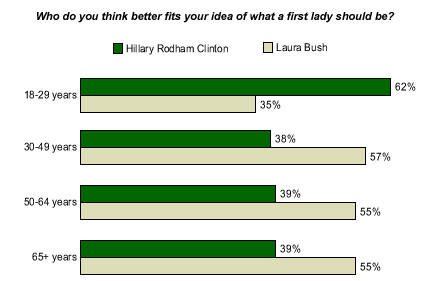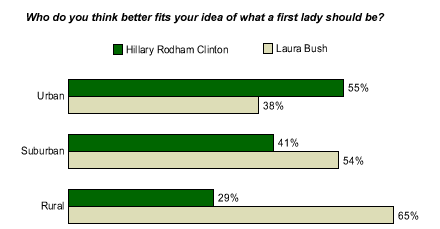Throughout American history, the roles first ladies have played have been as different as the first ladies themselves. Some first ladies have sought to shape White House policy, while others have focused more on White House décor and the arts. Many first ladies have championed important social causes; others have championed their husbands' re-election campaigns.
Given that history, gauging what the public thinks a first lady should be proves interesting, especially because the nation's last two first ladies have adopted such different public personas. A recent Â鶹´«Ã½AV Poll* asked Americans who they think better fits their idea of what a first lady should be, Laura Bush or Hillary Rodham Clinton. More Americans believe Bush fits the bill, 52% to 43%. The remaining 5% feel that both women equally fit their idea of a first lady or neither of them do, or have no opinion.
Politics as Usual
The husbands of these two first ladies represent different parties. So, perhaps not surprisingly, opinion on who is the ideal first lady varies dramatically by partisanship. Eight-six percent of Republicans believe Bush better fits their idea of what a first lady should be. Among Democrats, 71% think Clinton is a better fit. Bush maintains a slight edge among independents, 51% to 42%.
Age and Community Gaps
Even when controlling for partisanship, opinions on who makes a better first lady vary by age and the type of community a person lives in. Specifically, younger people and those living in urban areas are more likely to think Clinton was a better fit as first lady, while those in other age groups and community types favor Bush.
A majority of Americans between the ages of 18 and 29 -- 62% -- think Clinton better fits their idea of what a first lady should be, compared with 35% who think Bush does. However, Bush better fits the idea of a first lady among Americans in all three of the older age groups tested, all by a margin of at least 16 percentage points.
The generational divide in preferences for Clinton over Bush could stem from the fact that Clinton was known for a more outspoken, aggressive style than most first ladies preceding her, while Bush has tended to embody a more traditional first lady role -- perhaps one that most older Americans are more accustomed to. As a recent Bush profile in USA Today put it, "Laura Bush's priorities as first lady have been mostly traditional, a deliberate shift from the activist political agenda of Hillary Clinton."

When it comes to the type of community one lives in, Clinton is preferred to Bush by a majority of those living in urban areas. Among suburbanites, slightly more believe Bush better fits their idea of a first lady. For those living in rural areas, Bush is the overwhelming choice.

Gender
Opinion of which woman better fits the public's opinion of what a first lady should be varies slightly by gender. Both men and women are more likely to believe Bush better fits their ideal, but men somewhat more so than women. Specifically, 55% of men say Laura Bush best fits their idea of a first lady, while 40% believe Clinton does. Among women, the responses are more evenly divided, with 50% saying Bush is the better fit, and 45% saying Clinton is.
Bottom Line
In a head-to-head matchup concerning who better fits the public's idea of what a first lady should be, Bush as an edge over Clinton. However, Clinton makes significant gains among young people and urban dwellers. Generally, opinions on the topic also vary along the same political lines that define their husbands' presidencies.
*These results are based on telephone interviews with a randomly selected national sample of 1,005 adults, aged 18 and older, conducted June 21-23, 2004. For results based on this sample, one can say with 95% confidence that the maximum error attributable to sampling and other random effects is ±3 percentage points. In addition to sampling error, question wording and practical difficulties in conducting surveys can introduce error or bias into the findings of public opinion polls.
